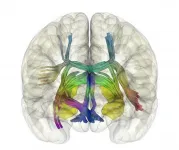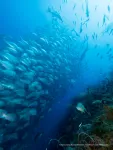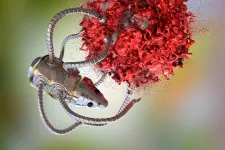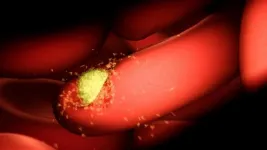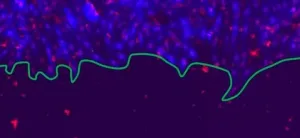New research shows long-term recovery possible for areas impacted by seagrass die-off
2021-05-03
(Press-News.org) Nearly 10,000 acres of lush seagrass vanished from Florida Bay between 1987 and 1991, leading to massive ecological changes in the region near the Florida Keys. Abundance of the seagrass, Thalassia testudinum, more commonly known as turtlegrass, a foundation species of the Florida Bay ecosystem, decreased extensively during what is considered to be one of the largest declines in seagrass cover in recent history.
Researchers from the University of South Florida, the Florida Fish and Wildlife Conservation Commission (FWC) and the University of North Carolina Wilmington documented the response of seagrasses after the die-off. Their detailed data collection for over 20 years across the large area of impact has provided unique insight into seagrass resiliency or the ability of a coastal ecosystem to recover after the extensive loss. This study, published in "Scientific Reports," is extremely timely as the work provides a framework for how future recovery of a new seagrass die-off, recorded in 2015 in the same location, may still be possible.
Seagrass plays an important role across much of the Gulf of Mexico and Caribbean Sea, providing critical habitat and feeding grounds for many species of fish, turtles and other wildlife. They're considered to be one of the most productive ecosystems in the world and in Florida Bay contribute to a sport fishing industry worth hundreds of millions of dollars per year.
USF Distinguished University Professor Susan Bell first learned of the 1987 large-scale seagrass die-off in Florida when she got a call from a long-time fisherman friend who noticed the seagrass disappearing and large amounts of dead seagrass. Bell notified colleagues at FWC, who began to detail what was happening across a roughly 15 square mile stretch of the bay.
For more than 10 years, researchers saw little to no change in seagrass, especially in the levels of turtlegrass. However, after another decade of monitoring, researchers reported a return to pre-die-off levels of turtlegrass in the region. The study shows that the entire sequence of die-off, algal blooms and recovery took 17-23 years. Both the long duration of the study and large area over which the data were systematically collected were unique to reports of seagrass recovery. Also, most studies of marine populations that recover from some kind of disturbance are linked to human intervention, such as removing a source of pollution, but in this case the recovery required no human activities.
"While the fact this system recovered after the 1980s die-off is fantastic, we really wanted to figure out the mechanisms that allowed recovery to happen," said Bell, a faculty member in the USF Department of Integrative Biology. "What we discuss are a number of features that underlie the seagrass recovery: the system was remote, remnants of seagrass leftover after the die-off served as a catalyst for repopulation and having multiple species of seagrass present increases the likelihood for recovery."
In the last case, two opportunistic seagrass species were first to increase in abundance after the die-off and likely facilitated the return of turtlegrass.
Bell believes this study can serve as a framework for other regions experiencing seagrass die-off, including once again in Florida Bay, which is still in the midst of the die-off that began in 2015. Their work warns that evaluation of ecosystem resiliency may take decades to detect, mandating long-term studies. Researchers are continuing to study the changes in Florida Bay, but are hopeful that with the right conditions, the region can once again return to normal.
"Today, this monitoring program provides some of our best information on the status of the system," said Brad Furman, a co-author of the study and research scientist at FWC's Fish and Wildlife Research Institute. "Studies like this one allow us to set expectations for recovery, something we did not have in the 1990s, which is extremely important as we watch the Bay respond to the most recent die-off event."
INFORMATION:
[Attachments] See images for this press release:
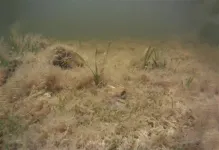
ELSE PRESS RELEASES FROM THIS DATE:
2021-05-03
31 percent of pet dogs and 40 percent of pet cats tested positive to COVID-19 after their owners' own diagnoses, though under half displayed symptoms, in small Brazilian study.
INFORMATION:
Publicly available article: https://journals.plos.org/plosone/article?id=10.1371/journal.pone.0250853
Article Title: Investigation of SARS-CoV-2 infection in dogs and cats of humans diagnosed with COVID-19 in Rio de Janeiro, Brazil
Funding: MMS: This study was supported by CGLab/MoH (General Laboratories Coordination of Brazilian Ministry of Health), CVSLR/FIOCRUZ (Coordination of Health Surveillance and Reference Laboratories ...
2021-05-03
Thanks to the so-called deep learning, a subset of artificial intelligence (AI) algorithms inspired by the brain, machines can match human performance in perception and language recognition and even outperform humans in certain tasks. But do these synthetic biologically inspired systems learn in the same way that we do?
According to a new article by first author Dr. Diogo Santos-Pata from the Synthetic Perceptive, Emotive and Cognitive Systems lab (SPECS) at IBEC led by ICREA Professor Paul Verschure, in collaboration with Prof. Ivan Soltesz at Stanford University, the mechanism of autonomous learning underlying these AI systems reflects nature more closely than previously thought. With their hypothesis and model, these scientists offer new insights into ...
2021-05-03
A world first study within the Great Barrier Reef Marine Park has found limited fishing zones (yellow zones) are still important conservation and fisheries management tools when paired with no-fishing zones.
Lead author Dr April Hall, from the ARC Centre of Excellence for Coral Reef Studies at James Cook University (Coral CoE at JCU), said partially protected yellow zones still contain healthy numbers of reef fish targeted for recreational and commercial fishing. These include coral trout, tropical snappers, emperors and tuskfish.
Yellow zones limit, rather than prohibit, fishing through fishing gear restrictions. For example, limited line fishing is allowed with one rod or line and one hook per ...
2021-05-03
Bowel cancer survival rates could be improved if chemotherapy drugs were delivered via tiny nanoparticles to the diseased organs rather than oral treatment.
That's the finding from Indian and Australian scientists who have undertaken the first study, using nanoparticles to target bowel cancer, the third most common cancer in the world and the second most deadliest.
The researchers have shown in animal experiments that nanoparticles containing the chemotherapy drug Capecitabine (CAP) attach themselves directly to the diseased cells, bypassing healthy cells and therefore reducing toxic side effects as well as the size and number of tumours.
The scientists, from the Manipal Academy of Higher Education, Indian Institute of Science and the University of South Australia, ...
2021-05-03
National Health and Medical Research Council, the European Research Council and the Victorian Government.
WEHI researchers have identified how natural human antibodies can block malaria parasites from entering red blood cells, potentially indicating how new protective therapies could be developed against this globally significant disease.
The research provides greater insight into how antibodies block the entry of Plasmodium vivax malaria parasites into young red blood cells called reticulocytes. It builds on an earlier discovery that the P. vivax latches onto the transferrin receptor 1 (TfR1) to enter cells.
The research, led by Associate Professor Wai-Hong Tham and PhD student Li-Jin Chan ...
2021-05-03
Many drug addicts take not only one substance but rather several. Scientists at the Max Planck Institute of Experimental Medicine in Göttingen have investigated the role that genes and the environment play in the development of such multiple substance consumption or polytoxicomania. Their results show that, in addition to genetic factors, the accumulation of several unfavourable environmental factors causes people to slip into such an extreme form of multiple drug use. Among the risk factors were sexual and physical abuse, living in a big city, and migration experience as well as the use ...
2021-05-03
Aromaticity, a concept usually used to explain the striking stability and unusual reactivity of certain carbon-based molecules, could inspire the design of new catalysts with novel uses, KAUST researchers have shown.
Chemists first came upon the anomalous behavior of aromatic molecules in the nineteenth century while studying benzene. The unexpected stability of this six-carbon cyclic structure comes down to its electrons.
In general, bonding electrons hold a specific pair of atoms together in a discrete chemical bond. But in benzene, six electrons form a delocalized ring across the molecule. A host of other molecules share this feature. "Many classic examples of organic and organometallic reactivity can be explained on this basis," says Théo Gonçalves, ...
2021-05-03
In material physics understanding how systems interact across the interfaces separating them is of central interest. But can physical models clarify similar concepts in living systems, such as cells? Physicists at the University of Geneva (UNIGE), in collaboration with the University of Zurich (UZH), used the framework of disordered elastic systems to study the process of wound healing - the proliferation of cell fronts which eventually join to close a lesion. Their study identified the scales of the dominant interactions between cells which determine this process. The results, published in the journal Scientific Reports, will allow better analysis of cell front behaviour, in terms of both wound healing and tumour development. In the future, this approach may offer personalised diagnostics ...
2021-05-03
Scientists are warning that drinking water supplies in parts of rural West Africa are being contaminated by lead-containing materials used in small community water systems such as boreholes with handpumps and public taps.
They analysed scrapings taken from the plumbing of 61 community water supply systems in Ghana, Mali and Niger. Eighty percent of the tested systems had at least one component that contained lead in excess of international guidance.
Lead is released into the water when the components corrode.
The study, by a research team from the University of Leeds, University of North Carolina at Chapel Hill and Boston University, also took samples of the water from those 61 water distribution systems, ...
2021-05-03
Migratory waterbirds are particularly exposed to the effects of climate change at their breeding areas in the High Arctic and in Africa, according to a new study published in Bird Conservation International. The research team came to this conclusion after modelling climatic and hydrological conditions under current and future climate scenarios (in 2050) and comparing the impact on the distribution of 197 of the 255 waterbird species listed under the Agreement on the Conservation of African-Eurasian Migratory Waterbirds (AEWA). The international team was led by Wetlands International, BirdLife International, and the British Trust for Ornithology, involved researchers from various universities, including McGill. The results suggest that investing more in habitat conservation in the wider ...
LAST 30 PRESS RELEASES:
[Press-News.org] New research shows long-term recovery possible for areas impacted by seagrass die-off

